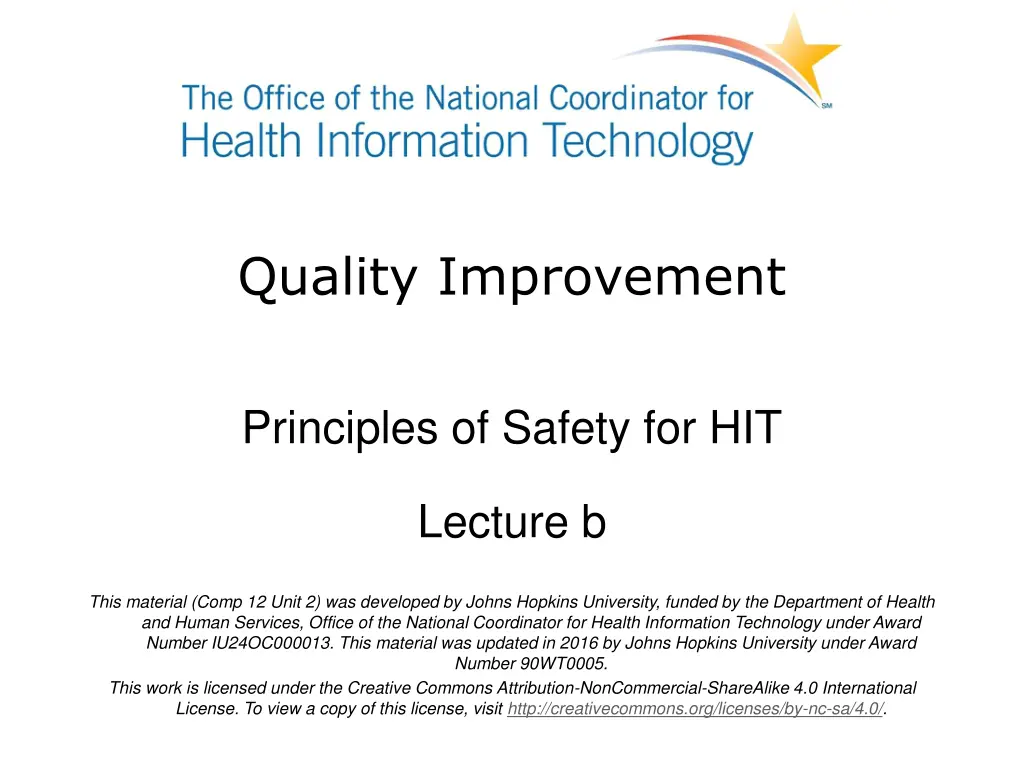
Principles of Safety for HIT Lecture
Explore the principles of safety and quality improvement for Health Information Technology with learning objectives, safe design principles, and practical tips. Content created by Johns Hopkins University under government funding, emphasizing the importance of standardization, independent checks, and communication in healthcare settings.
Download Presentation

Please find below an Image/Link to download the presentation.
The content on the website is provided AS IS for your information and personal use only. It may not be sold, licensed, or shared on other websites without obtaining consent from the author. If you encounter any issues during the download, it is possible that the publisher has removed the file from their server.
You are allowed to download the files provided on this website for personal or commercial use, subject to the condition that they are used lawfully. All files are the property of their respective owners.
The content on the website is provided AS IS for your information and personal use only. It may not be sold, licensed, or shared on other websites without obtaining consent from the author.
E N D
Presentation Transcript
Quality Improvement Principles of Safety for HIT Lecture b This material (Comp 12 Unit 2) was developed by Johns Hopkins University, funded by the Department of Health and Human Services, Office of the National Coordinator for Health Information Technology under Award Number IU24OC000013. This material was updated in 2016 by Johns Hopkins University under Award Number 90WT0005. This work is licensed under the Creative Commons Attribution-NonCommercial-ShareAlike 4.0 International License. To view a copy of this license, visit http://creativecommons.org/licenses/by-nc-sa/4.0/.
Principles of Safety for HIT Learning Objectives Lecture b Investigate the fallibility of people and systems. Describe the ways that every system is designed to achieve the results it gets. Apply the basic principles of safe design. Explain the ways that teams make wise decisions with diverse and independent input. 2
Principles of Safe Design Standardize. Eliminate steps if possible. Create independent checks. Learn when things go wrong. What happened? Why did it happen? What did you do to reduce risk? How do you know it worked? 3
Create Independent Checks Image courtesy Gerdbrendel, Creative Commons. 6
Dont Play Man Down: When You Feel Something, Say Something! 9
Your Role Assume things will go wrong. Develop lenses to see systems. Work to mitigate technical and teamwork hazards: Standardize work. Create independent checks. Learn from mistakes. Make wise decisions by getting input from others. Keep the patient the North Star. 10
Principles of Safety for HIT Summary Lecture b In this unit we ve learned about the ways that teams make wise decisions with diverse and independent input. We ve also explored the importance of communication and especially the place of critical listening. 12
Principles of Safety for HIT References Lecture b 1 References Dayton, E. (2007 January). Joint Commission Journal. Johns Hopkins Hospital. (2004). Josie King. Available from: http://www.hopkinsmedicine.org/hmn/s04/feature1.cfm Reason, J. (2000). BMJ 320:768 770. Images Slide 4: A woman peers into a microscope to examine a circuit board. Courtesy National Science Foundation. Available from http://nsf.gov/ Slide 5: A bank of ATMs. Creative Commons: Piotrus. Available from: http://commons.wikimedia.org/wiki/File:PNC_bank_ATMs.JPG Slide 6. A three-point seat belt in a Lincoln Town Car. Creative Commons: Gerdbrendel. Available from: http://en.wikipedia.org/wiki/File:Seatbelt.jpg Slide 7: Basic components of communication. Courtesy Elizabeth Dayton, (2007 January). Joint Commission Journal. Slide 8. Jelly Beans. Creative Commons: Brandon Dilbeck. Available from: http://3.bp.blogspot.com/- oxxwjc9sQp8/TbCxyVKPtWI/AAAAAAAAAcA/NkPtINLsFjw/s1600/jelly-beans.jpg 13
Principles of Safety for HIT References Lecture b 2 Images Slide 9: Johns Hopkins lacrosse team. Courtesy Johns Hopkins University. Slide 11. Josie King. Pronovost, P. (2009 February). 10 years after To Err is Human : An RCA of Patient Safety Research? Rockville, MD: Agency for Healthcare Research and Quality. Retrieved March 29, 2016, from: http://archive.ahrq.gov/news/events/conference/2008/Pronovost.ppt 14
Quality Improvement Principles of Safety for HIT Lecture b This material (Comp 12 Unit 2) was developed by Johns Hopkins University, funded by the Department of Health and Human Services, Office of the National Coordinator for Health Information Technology under Award Number IU24OC000013. This material was updated in 2016 by Johns Hopkins University under Award Number 90WT0005. 15






















